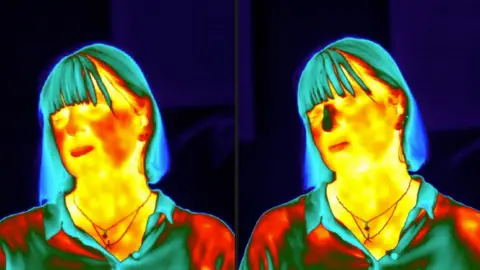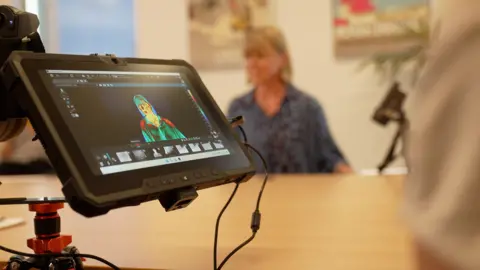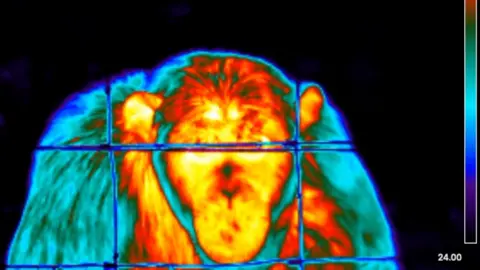Victoria GillScience correspondent for BBC News
When I was asked to give an impromptu five-minute speech and then count backwards in 17-time intervals—all in front of a group of three strangers—my face showed acute tension.
That's because psychologists from the University of Sussex filmed the somewhat frightening experience for a research project into stress using thermal imaging cameras.
Stress changes blood flow in the face, and scientists have found that a drop in a person's nasal temperature can be used as a measure of stress levels, as well as to monitor recovery.
Thermal imaging could be a “game changer” in stress research, according to the psychologists behind the study.
 Kevin Church/BBC
Kevin Church/BBCThe experimental stress test I subjected myself to is carefully controlled and deliberately designed to provide an unpleasant surprise. I arrived at the university with no idea what awaited me.
First, I was asked to sit down, relax, and listen to white noise through headphones.
So far so calming.
The researcher conducting the test then invited a group of three strangers into the room. They all stared at me silently as the researcher announced that I now had three minutes to prepare a five-minute speech about my “dream job.”
As I felt the heat rise around my neck, the scientists used their thermal imaging camera to capture my face changing color. The temperature of my nose dropped quickly and it turned blue on the thermal image as I contemplated how to get through this unplanned presentation. (I decided that I would take the opportunity to make an offer to join the astronaut training program!)
Researchers from Sussex conducted the same stress test on 29 volunteers. In each of them, they saw that their nose temperature dropped by three to six degrees.
The temperature of my nose dropped two degrees as my nervous system pushed blood flow from my nose to my eyes and ears—a physical response that helps me see and listen for danger.
Most of the participants, like me, recovered quickly; their noses warmed to pre-stress levels within minutes.
Lead researcher Professor Gillian Forrester explained that working as a reporter and presenter had probably made me “quite used to being in stressful situations”.
“You're used to being on camera and talking to strangers, so you're probably pretty resilient to social stressors,” she explained.
“But even in someone like you who is trained to be in stressful situations, there is a biological shift in blood flow, which suggests that nasal congestion is a reliable marker of changes in stress.”
 Kevin Church/BBC News
Kevin Church/BBC NewsStress is a part of life. But this discovery, scientists say, could be used to manage harmful levels of stress.
“The length of time it takes a person to recover from this nosebleed may be an objective measure of how well a person regulates their stress,” Professor Forrester said.
“If they recover unusually slowly, could this be a marker of risk for anxiety or depression? Is there anything we can do about it?
Because this method is non-invasive and measures a physical response, it can also be useful for monitoring stress in infants or people who are unable to communicate.
The second task in my stress assessment was, in my opinion, even worse than the first. I was asked to count backwards, starting in 2023, in increments of 17. One of three emotionless strangers stopped me every time I made a mistake and asked me to start again.
I admit, I'm not good at mental arithmetic.
As I spent an awkward time trying to force my brain to do the subtraction, all I could think about was that I wanted to escape the increasingly stuffy room.
During the study, only one of the 29 volunteers who took part in the stress test actually asked to leave. The others, like me, completed their tasks – presumably feeling varying degrees of humiliation – and were rewarded at the end with another soothing session of white noise via headphones.
Anxious monkeys
Professor Forrester will demonstrate this new method of measuring thermal stress to an audience at the New Scientist Live event in London on 18 October.
Perhaps one of the most surprising aspects of this approach is that because thermal imaging cameras measure the physical stress response common to many primates, they can also be used in great apes.
Researchers are currently developing possibilities for its use in sanctuaries for great apes, including chimpanzees and gorillas. They want to figure out how to reduce stress and improve the well-being of animals who may have been rescued from traumatic circumstances.
The team has already found that showing adult chimpanzees videos of baby chimpanzees has a calming effect. When researchers installed a video screen near the rescued chimpanzees' enclosure, they saw the animals' noses warm up as they watched the footage.
So, from a stress perspective, watching baby animals play is the opposite of a surprise job interview or on-the-spot subtraction problem.
 Jilly Forrester/University of Sussex
Jilly Forrester/University of SussexThe use of thermal imaging cameras in monkey sanctuaries can be beneficial in helping rescued animals adapt and adapt to a new social group and unfamiliar environment.
“They can't say what they feel, but they can hide their feelings quite well,” explained Marianne Paisley, a researcher at the University of Sussex who studies monkey well-being.
“We have [studied] primates over the last 100 years or so to help us understand ourselves.
“We now know so much about people’s mental health that maybe we can use that and bring the benefits back to them.”
So perhaps my own little scientific trial could go some way to alleviating the suffering of some of our primate relatives.
Additional reporting by Kate Stevens. Photography by Kevin Church









